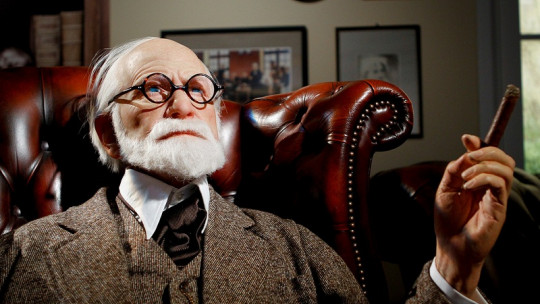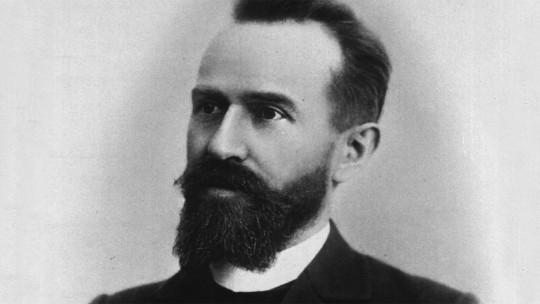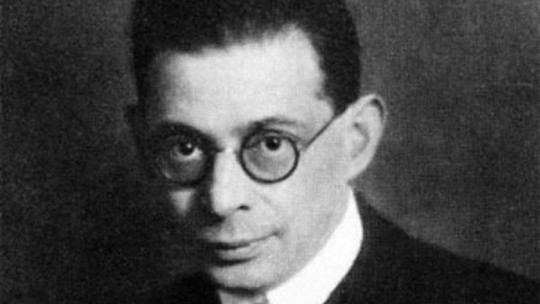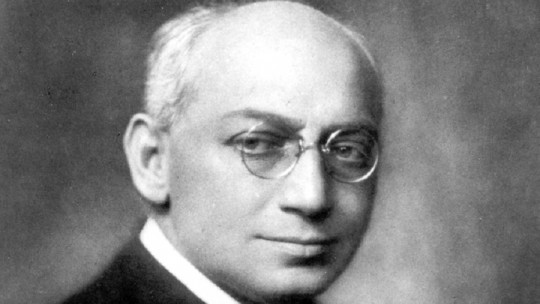Sigmund Freud He is, perhaps, the most famous, controversial and charismatic thinker in 20th century psychology.
His theories and work have left an important mark on the way in which for decades explanations have been given about childhood development, personality, memory, sexuality and therapy. Many psychologists have been influenced by his work, while others have developed his ideas in opposition to him.
Today, scientific psychology develops outside the ideas of Sigmund Freud. However, that does not diminish the historical value of this researcher. Next we will review his life and his work through a biography of Sigmund Freud in which we will learn about his vital and intellectual career.
Brief biography of Sigmund Freud, father of psychoanalysis
Freud is the father of psychoanalysis, a method that aims to treat mental illnesses. Freudian psychoanalysis is a theory that attempts to explain the behavior of human beings and is based on the analysis of unconscious sexual conflicts that originate in childhood.
This theory maintains that instinctive impulses that are repressed by consciousness remain in the unconscious and affect the subject. The unconscious is not observable by the patient: the psychoanalyst is the one who must make these unconscious conflicts accessible through interpretation of dreams, failed acts and free association
The concept called “free association” is a technique that seeks for the patient to express, during therapy sessions, all their ideas, emotions, thoughts and images as they are presented to them, without restrictions or orders. After this opening, the psychoanalyst must determine which factors, within these manifestations, reflect an unconscious conflict.
Early years and university training
Sigmund Freud was born in Freiberg, Austria, in 1856 within a Ukrainian family of Jewish origin and a humble economic situation.
When 1860 arrived, his family moved to Vienna, and settled in this city for the following years. At the age of 17, young Freud entered the University of Vienna to study medicine, graduating shortly after. Then, around 1877, He specialized in the study of the nervous system in fish an area in which he stood out as a researcher.
Then, in 1882, he began working as a doctor at the Vienna General Hospital. In 1886 he married Martha Bernays and began private practice specializing in disorders based on alterations in the nervous system. However, he soon became interested in the purely psychological. Around 1889, he began to develop psychoanalytic theory.
Sigmund Freud’s relationship with Charcot and Breuer: Origin of Psychoanalysis
To understand his theory, you have to know that it all started in Paris, where Sigmund Freud was thanks to a scholarship. There he spent a lot of time with Jean-Martin Charcot , a famous neurologist who studied the hypnotic phenomenon, and thus began his interest in suggestion and the study of hysteria. Once the fellowship was over, Freud returned to Vienna and shared Charcot’s theories with other doctors, but they all rejected him except Joseph Breuer a friend of his.
Besides, Breuer played a very important role in Sigmund Freud’s life as a father figure advising him on the different aspects of the career they shared, supporting him financially to establish his office as a private doctor, creating the cathartic method and writing with it the inaugural work in the history of psychoanalysis.
The famous case of Anna O.
In case of Anna O. (her real name was Bertha Pappenheim) marked a before and after in the career of a young Freud Anna O. was a patient of Breuer’s who suffered from hysteria, but they both took care of her problem. The patient was a young woman who fell ill in the fall of 1880. When she was 21 years old, her father unexpectedly fell ill and she was forced to take care of him. Her attention to her father was so great that the great neglect she gave to herself led her to anemia and weakness. But these problems; which soon put her in bed, were followed by even more alarming discomforts: paralysis, a serious disturbance of speech and other symptoms that appear after the death of her father, and for which she is diagnosed as hysterical.
Breuer’s treatment focused on inducing the patient into a hypnotic state and persuading her to recall the circumstances prior to the first appearance of each of the symptoms suffered. Upon emerging from the hypnotic trance, these hysterical symptoms disappeared one by one. The doctor performed this treatment twice a day, and Anna O. used to call it the “talking cure.” Breuer called it a cathartic method. In the case of Anna O., it was concluded that she had suffered sexual abuse during her childhood by a family member, and although the therapy seemed to work, a sexual transference appeared between the patient and the doctor. Then there were problems with a false pregnancy of the patient, who was in love with her therapist, and Breuer left, harassed by his wife’s jealousy.
Breuer and hysteria
Breuer concluded that patients who showed the symptoms of hysteria did not have physical ailments but, in reality, their symptoms were the result of the permanent action of certain traumatic experiences from the past that had been repressed, although not forgotten. , and furthermore, that by releasing these repressed thoughts, externalizing them and consciously accepting them, the symptoms disappeared.
Breuer did not initially make his discoveries public, but he shared them with Freud. The latter used this method, but left aside hypnosis and instead established the “free association” procedure.
Later, the relationship between Breuer and Freud began to decline due to various arguments in the scientific field. Breuer adhered to a classical scientific conception that did not accept the total separation between physiology and psychology while Freud opted for the creation of a whole new theoretical system for psychology and absolute independence from any other medical branch.
On the other hand, Breuer conceived the cathartic method with hypnosis, but without the adoption of “free association” or other modifications and extensions suggested by Sigmund Freud. The friendship finally broke down definitively a year after a joint publication.
The unconscious mind
Sigmund Freud developed a topographical map of the mind in which he described the characteristics of the structure and functioning of the mind. In this model, the conscious mind is just the tip of the iceberg Many of our primitive impulses and desires rest in the unconscious mind, which are mediated by the preconsciousness
Freud developed the theory that some events and desires caused his patients so much fear and pain that They remained stored in the dark subconscious , affecting behavior in a negative way. This happened due to the process called “repression.”
In his theory he gives a lot of importance to the unconscious mind, since the objective of psychoanalysis is to make conscious what is bothering the unconscious.
However, he still needed to know the mechanisms by which unconscious psychological processes take place. As we will see, he soon developed a series of concepts created to understand the way in which, hypothetically, the unconscious dominates the conscious.
The psychic instances
Later, Freud developed a model of the mind that was composed of the IT, the SELF, and the SUPER-EGO, and called it the “psychic apparatus.” As he IT he I and SUPER-ME They are not physical areas, but rather hypothetical conceptualizations of important mental functions.
When you are born you are all IT, your needs for food, hygiene, sleep and contact must be satisfied immediately, because you do not have the capacity to wait, that is, you are governed by a pleasure principle, you are impatient. Little by little he learns to wait, he perceives that someone is encouraging him, he distinguishes situations, that is the moment in which the SELF emerges and as he grows he continues with his learning.
Among these learnings, he distinguishes that there are things that he cannot do and others that he can, and that is when the SUPER-EGO begins to form. A child guides her behavior as indicated by the adults who give her rewards or punishments depending on whether or not she responds to the rules or instructions they give.
Defense mechanisms
Freud tells us about defense mechanisms, such as the techniques of the unconscious, responsible for minimizing the consequences of too intense events. In this way, through these mechanisms, the individual is able to function normally. It is a response of the EGO, which defends itself both from the excessive pressure of the IT, when it demands the satisfaction of impulses, and from the excessive control of the SUPER-EGO; Thanks to them, the SELF is also protected from the presence of past traumatic experiences.
Defense mechanisms are incorrect ways of resolving psychological conflict and can lead to disorders in the mind, behavior, and in the most extreme cases to the somatization of the psychological conflict and the physical dysfunctions that express it. These are some of the defense mechanisms:
Displacement
It refers to the redirection of an impulse (usually aggression) towards a person or an object. For example, someone who feels frustrated with his boss and kicks his dog.
Sublimation
It is similar to displacement, but the momentum is channeled into a more acceptable form. A sexual drive is sublimated towards a non-sexual purpose, aiming at socially valued objects, such as artistic activity, physical activity or intellectual research.
Repression
It is the mechanism that Freud discovered first. He refers to the SELF erasing events and thoughts that would be painful if they were kept at the conscious level.
Projection
It refers to individuals who attribute their own thoughts, motives or feelings to another person. The most common projections may be aggressive behaviors that provoke a feeling of guilt, and sexual fantasies or thoughts.
Denial
It is the mechanism by which the subject blocks external events so that they are not part of consciousness and treats obvious aspects of reality as if they do not exist. For example, a smoker who refuses to face the fact that smoking can cause serious health problems.
Stages of Freud’s theory
The time in which the author of the psychosexual theory lived, and in which the strong repression of sexual desires was common, especially in the female sex, Sigmund Freud understood that there was a relationship between neurosis and sexual repression. Therefore, it was possible to understand the nature and variety of the disease by knowing the patient’s sexual history.
Freud considered that children are born with a sexual desire that they must satisfy, and that there are a series of stages, during which the child seeks pleasure from different objects. This is what led to the most controversial part of his theory: the theory of psychosexual development.
Oral stage
It begins at birth and continues during the first 18 months of life. This stage focuses on pleasure in the mouth, that is the erogenous zone. The child sucks everything he finds because it is pleasurable and thus he knows his surroundings. Therefore, in this phase the child is already experimenting with his sexuality. If the adult, for example, prohibits him from sucking his finger, hand, etc. He is blocking his ability to explore himself and the world around him. Which can bring future problems for the child.
anal stage
The anal phase of development occurs between 18 months and three years of age. At this stage the concern of the child and his parents revolves around the anus, it is the stage of sphincter control. Sexual enjoyment for the child is in defecation. He feels that he gives, a production of his body, a part of himself and that is why it is so important to him.
It is a stage of great importance and it is essential that sphincter control is done progressively, without pressure. Mishandling this stage will have a negative impact on future behavior.
phallic stage
The phallic phase of Sigmund Freud’s theory begins at age three and lasts until age six. At this stage the genitals are the object of pleasure and interest in sexual differences and genitals appears, so it is very important not to repress and properly manage this stage, since it could obstruct the capacity for research, knowledge and general learning. . Freud claims that men begin to experience sexual feelings towards their mothers and see their fathers as competitors, so they fear being castrated, a process that results in the Oedipus Complex. Later, children identify with their fathers and repress their feelings towards their mothers to leave this phase behind.
Latency stage
Freud’s latency phase develops between the age of six and the beginning of puberty. It coincides with the school stage and for a long time it was wrongly believed that sexuality remained dormant, latent. What happens is that during this period the child’s interest focuses on knowing, learning and investigating. Good management of the previous stages contributes very favorably to academic success.
genital stage
This phase occurs during puberty, and once again, the focus falls on the genitals. Individuals show curiosity about genital sexuality and it is essential that they find in their parents and in the adult world the openness and availability to talk about sex and to clarify and answer their doubts.
Dream analysis
Freud considered that dreams were important to explain what was happening in the unconscious, since while we dream the ego’s defenses are not present. Because of this, much repressed material becomes conscious, albeit in a distorted way. Remembering fragments of dreams can help uncover buried emotions and memories. Therefore, dreams play an important role in the unconscious mind and serve to give clues to how it operates.
Sigmund Freud distinguished between manifest content (what is remembered from the dream) and latent content , the symbolic meaning of the dream (what it is trying to say). The first is superficial and the second manifests itself through the language of dreams. The author of the “Theory of Dream Interpretation” mentions that all dreams represent the fulfillment of a wish by the dreamer, even nightmares. According to his theory, the “censorship” of dreams produces a distortion of their content. So what may seem like a set of meaningless dream images, through analysis and its “deciphering” method, can actually be a set of coherent ideas.
His legacy in Western thought
Freudian ideas had a great impact, and his work gathered a wide group of followers. Among them we can mention: Karl Abraham, Sandor Ferenczi, Alfred Adler, Carl Gustav Jung, Otto Rank and Ernest Jones. Some, like Adler and Jung, moved away from Freud’s principles and created their own psychological conception.
There is no doubt that Psychoanalysis has been revolutionary for psychology and has served as the basis for the development of a large number of psychological theories and schools. In its beginnings, and even today, it has been a doctrine that has awakened great passions, for and against Possibly one of the main criticisms refers to the lack of objectivity in observation and the difficulty of deriving specific verifiable hypotheses from this theory, but no matter how much they criticize it, in the development of psychology, there is a before and a after this famous person.









